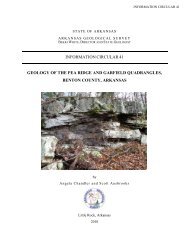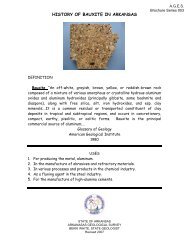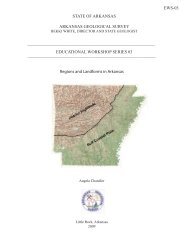Ice-age mammals - Arkansas Geological Survey
Ice-age mammals - Arkansas Geological Survey
Ice-age mammals - Arkansas Geological Survey
- No tags were found...
Create successful ePaper yourself
Turn your PDF publications into a flip-book with our unique Google optimized e-Paper software.
Pleistocene (<strong>Ice</strong>-Age) Mammals<br />
Between 1.8 and about 11,000 years ago the earth went through a series of<br />
colder climates when much of North American was covered by glaciers. This<br />
period is referred to as the <strong>Ice</strong> Ages or Pleistocene period of geologic time.<br />
Although <strong>Arkansas</strong> was not covered by ice, many large <strong>mammals</strong> lived here.<br />
Many groups of animals are represented by species living today and species that<br />
are now extinct. Examples of now extinct elephants are mastodons and wooly<br />
mammoths, wolves such as the dire wolf and cats like the saber tooth.<br />
Mammoth and mastodons<br />
Mammuthus columbi<br />
Pleistocene<br />
This is a tooth of the North American mammoth. Unlike the woolly mammoth<br />
which was adapted to cold climates this elephant lived in temperate regions. It is<br />
likely that the saber-toothed cat and the dire wolf saw this animal as prey.<br />
Below is a picture of mammoth tusks and teeth exposed during the excavation of<br />
a borrow pit for construction of Interstate 40, near Hazen <strong>Arkansas</strong>. The<br />
remains are housed at the University of <strong>Arkansas</strong> Collections Facility in<br />
Fayetteville, <strong>Arkansas</strong>.
Mastodon femur<br />
Pleistocene<br />
This is the thigh bone of a mastodon, an elephant-like creature which roamed<br />
various parts of the state maybe as recently as 12,000 years ago. Mastodons<br />
were somewhat smaller than modern elephants, standing about nine feet high.
Puma/Cougar<br />
Saber-tooth cat<br />
Smilodon californicus<br />
Pleistocene<br />
These cats were short limbed and were probably slow runners. The sabertoothed<br />
adaptation appears to have been specialization for feeding on large prey,<br />
possibly as a scavenger. The saber-toothed cat became extinct about 12,000<br />
years ago at about the same time as many of the large herbivores of the<br />
Pleistocene epoch. Remains of saber-toothed cats have been found at a few<br />
sites in north <strong>Arkansas</strong>.
A saber tooth cat tooth from the<br />
Conard Fissure, Newton<br />
County. From Fossils of<br />
<strong>Arkansas</strong> by Tom Freeman.
















